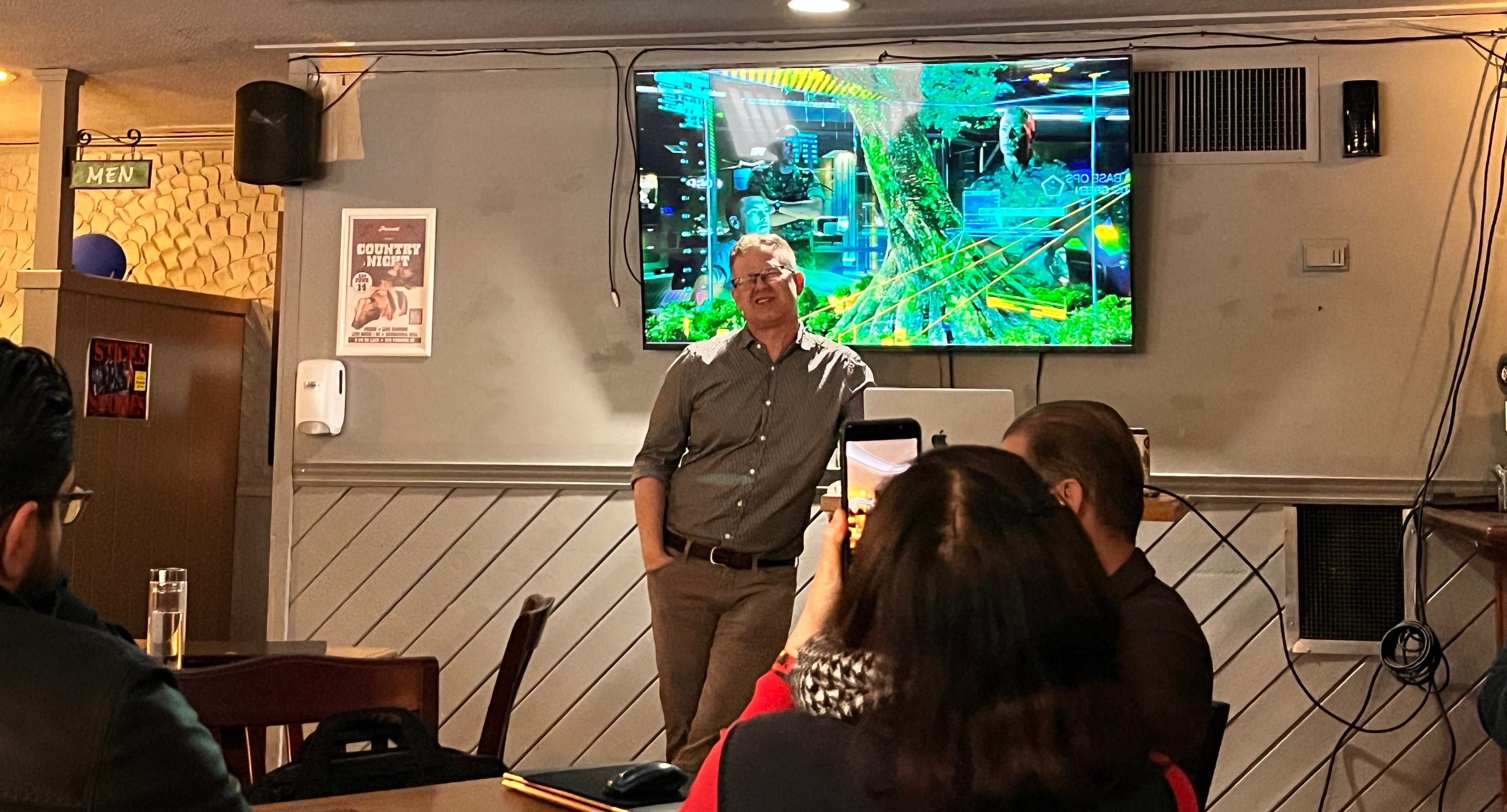A talk about finding product-market fit in unexpected places and building sustainable businesses that I gave at The Ottawa Network on May 22 2025

I'm Ben Houston, and over the past twenty years, I've built and sold computer graphics software that has powered the visual effects of hundreds of Hollywood films—from Harry Potter to Avatar, as well as the product marketing of Ralph Lauren, Logitech, Crate & Barrel, Starbucks, Sloan, Milwaukee Tools and Steelcase.
Today I want to share three hard-won lessons that can help Ottawa entrepreneurs build more successful companies.
Pivot towards Better Product Market Fits

Let me start with a story about the most expensive pivot of my career.
Clara.io to Threekit
What do I mean? If you are here and an entrepreneur you probably don't actually have a product market fit - you have an idea and you are likely forcing it on the market. Be prepared to listen to what the market is telling you and pivot to a better product market fit if you come across one.
I'll give you my direct experience with this. I spent over $1M in funding (much of it self funding) and two years building Clara.io, an online 3D editor, the first of its kind, launching it in 2013. It was revolutionary, and it quickly gained 100,000 users, media coverage, and technical achievements that seemed impossible in 2013. But we couldn't find paying customers because browser limitations make your product unusable for serious work.
Then one of the largest US office furniture company calls out of the blue. Steelcase wants to use our technology to help customers visualize highly configurable office chairs. Not revolutionary 3D collaboration—simple product visualization.
It was a weird request, sort of out of left field. It definitely was not my vision. We were building the future of 3D content creation, not a product configurator for boring office furniture. But I had to be honest with myself, we were also running out of money.
So I said yes to Steelcase, and within a few months landed a six-figure annual contract with them. And with that we pivoted away from the consumer space with Clara.io and became Threekit, the online product visualization platform. We went on to raise $65M for Threekit.com and employing over 100 people.
Internal Fluid Simulation Tool to Deadline
Here is the story of a second pivot I did into a really good PMF.
In 2002, I joined a Winnipeg VFX studio to write fluid simulations so they could win more contracts — you know, the water effects you see in movies. These fluid simulators took hours or days to run so running them on my own computer was a pain. To get around this I wrote my own distributed scheduler called "Cloud" to use idle office machines freeing up my machine to enable me to continue working.
Meanwhile, the studio had a different problem. They were using industry-standard software to manage their render farm of 60 machines for "The Core." This existing software was horrible, it crashed so often that they literally paid someone to work night shifts just to be around to restart the server. Without this human watchdog, they'd come in each morning to find failed renders and missed deadlines.
During a casual conversation about this insanity, we realized my little fluid scheduler probably could be adopted to solve their key business problem. There was an aspect of my simple design that happened to made it incredibly robust, I skipped having a central scheduler process and instead just used a distributed swarm design that coordinated via file system modifications. I actually did this design because I was lazy - I didn't want the pressure of having to design a perfect crash-free scheduler, but it turned out to be a key strength of the system - there was no central point of failure.
It took a few weeks to build out the fluid scheduler into a generic rendering scheduler and "Deadline" was born. It immediately addressed the crashing issue we suffered with. And with a ton of user feedback, it soon greatly outpaced the previously solution in terms of artist usability and feature richness.
My entrepreneurial orientation meant that I then pushed hard to commercialize this outside of the VFX studio, creating a formal software division. Our first external customer was Blizzard Entertainment, who needed it for World of Warcraft cinematics. They gave us this endorsement: "Deadline made our network rendering problems a thing of the past."
Within two years, Deadline was being used across Hollywood. Since then its been used on hundreds of major films and TV shows, including Game of Thrones, almost winning a Technical Oscar (twice!). It was eventually acquired by Amazon.
I wouldn't be surprised if there was opportunities like this in the companies you are part of.
Enterprise B2B Sales
When we started selling Threekit, the product visualization solution, we sold to anyone who would buy. While we did have Steelcase as an anchor client, we marketed and sold the solution to anyone. But overtime, we learned that this omnivorous approach was sub-optimal to say the least.
Selling to startups and small businesses:
- Very price sensitive - it better be relatively cheap, like a couple grand to $50K depending on business size.
- Easy to close deals with as there is often a single founder-decision maker who is action oriented.
- But startups and small businesses are often on the edge of failure or have cash flow issues
- If they run short on cash or shift focus, you'll get churn really quickly
- May be relying on your product to magically save/grow their business - unrealistic expectations
- Will not want long-term commitments, because the future is unpredictable
- Even successful ones have limited budgets for expansion
- Can not afford to invest in the relationship with them in a serious fashion
Large Enterprise (+200 employees)
- That initial $100K project? It's just the beginning
- They understand that complex projects have complex timelines
- They're flexible with change orders because they've worked with vendors before
- Massive expansion opportunities across divisions and departments
- Prefer longer commitments, 3 year deals are acceptable, but decision making can be slow.
Once we switched focus to large enterprises a lot of chaos in our business disappeared. We no longer were fighting to get bills paid (mostly.) Our churn dropped dramatically. Our customer service team was no longer overwhelmed with a ton of random issues. Instead we focused on just a few customers and we could now invest in proper follow-ups and tracking of them on our side, which just isn't possible if each customer is only worth a couple grand in yearly revenue.
The Land and Expand Strategy
This is one of the key benefits from an enterprise appraoch. In large enterprises, you can often expand to additional products and divisions within the same company. These are really cheap expansions because:
- Finance and legal already know you
- You've built credibility through successful delivery (you have already sold the company on your abilities because you've executed well on the last deal)
- You understand their internal politics
- Projects run smoother due to established relationships
Customer Success Managers
A key element of the enterprise land and expand strategy is "Customer Success Managers". You can not really afford them when dealing with startups and small businesses.
A CSM is the relationship manager with your existing enterprise customers. They do:
- Monthly check-ins to identify issues before they become major problems
- Repair relationships hiccups are encountered
- Identify expansion opportunities in other departments
- Turn one-time sales into ongoing partnerships
The math is simple and in favor of enterprise sales and growing those relationships. Acquiring new customers costs 3-8x more than expanding existing ones. CSMs often drive the majority of revenue growth in mature companies. If you're selling to enterprises without CSMs, you're leaving money on the table.
I should be clear that I am talking about complex products. If you have a simple product that is self-serve, go ahead and sell to startups and small businesses.
Your Product Is Only Part of the Value Equation
I initially thought that the product was the key value for our customers. But I've come around to the view that an enterprise customer is actually buying a combination of three things: the product, the integration of the product into their workflows/infrastructure and the relationship/trust they have with you.
The value of the integration
Complex software is useless unless it is integrated into the customers workflows/infrastructure. We found that we had to offer integration as part of our sales process. We would either do the integration ourselves or we would bring in a partner. The downside is that some integrations can be complex and if they go wrong, even if done by a partner, we would be the one held accountable.
One upside of integrations is that customers do not really understand where the integration ends and the product begins, which allows one to deliver features/capabilities for a customer within the integration if it isn't yet available in the product. And over time, you use the features/capabilities you delivered in integrations as a roadmap to future product features. This enables you to win deals you would normally lose.
The value of the relationship
With enterprise deals, there is an expectation that the relationship is going to be a long one and a tight one. There will be a many status meetings and deliveries. There will likely be some fires that arise or even miscommunications. Experienced enterprise customers know this and look to pick a vendor that can be consistent and professional and organized. In fact, because of the complex and the need for a long-term relationship, they would prefer a boring but professional vendor that a cutting edge but unproven vendor.
So you want to leverage this in your marketing and in your communications - you are a professional, organized, reliable, calm and proven. You will be there for the customer when they need you.
If this isn't you, bring in people to help.
.png)



